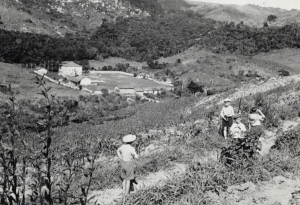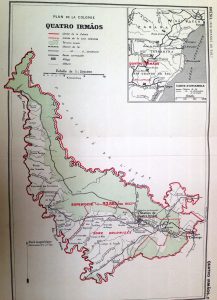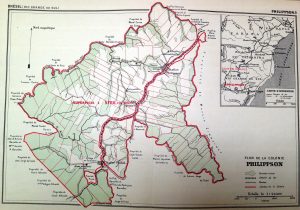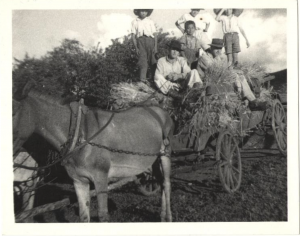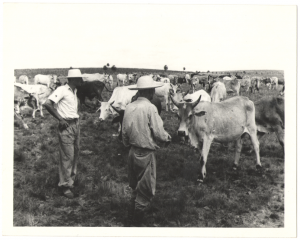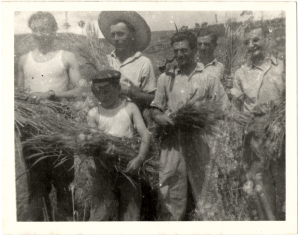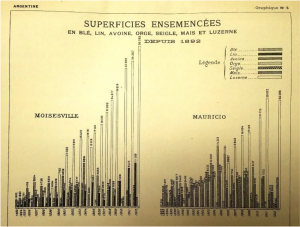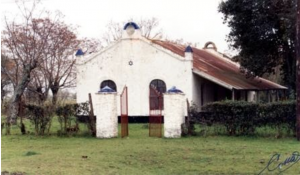South and Latin America
Today the story of Jewish agricultural settlement in South America is largely unknown outside older Jews in Argentina and Brazil, which hosted the major clusters of Jewish farming colonies on the continent. While most Jews outside of South America know little about this project, its scale was immense. All this was set into motion by multiple forces:
-
Jews from the Russian Empire desperate to escape repression and poverty.
-
Generous Jewish philanthropists willing to fund the migration of Jewish refugees from Eastern Europe to South America and then settle them on the land.
-
Liberal immigration policies in most South American and Latin countries, together with offers from those leaders to allot or sell vast tracts to Europeans as a means of populating their interior territories with people the leaders considered “productive” or simply whiter than the indigenous communities.
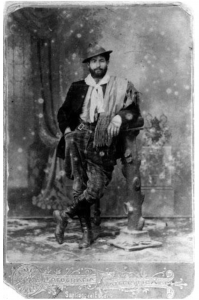
A Jewish “gaucho”, Argentina, 1909
Credit: The Jewish Community in Argentina Collection, Buenos Aires (AMIA)
Let’s consider early progress in Argentina versus Palestine at the end of the 19th century.
-
By 1896 the Lord Edmund de Rothschild had purchased a total of approximately 27,000 acres of farmland in Ottoman-controlled Palestine. These lands served as the core for the first decades of Zionist agricultural settlement in the Holy Land. By that same year, the “Lovers of Zion” movement had settled another approximately 2,300 acres in Ottoman Palestine.
-
At around the same time Baron Maurice de Hirsch had already purchased more than 250,000 acres of land for Jewish agricultural settlement in Argentina.
-
From 1882-1900, 3,590 Jews settled in Ottoman Palestine, some of them in Jewish colonies (moshavot).
-
From 1891-1896, a total of 6,757 Jews had emigrated to Argentina from Eastern Europe, many of them settled in Jewish colonies.
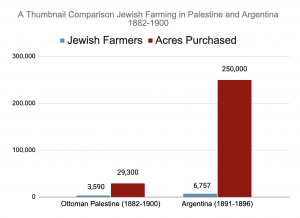
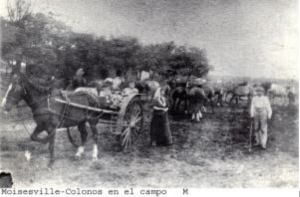
Credit: AMIA Collection
Funded and supervised by Baron de Hirsch’s Jewish Colonization Society (JCA), by the 1920s several dozen agricultural colonies on the pampas of Argentina and Brazil created a Jewish rural presence of tens of thousands of farmers on approximately 1.5 million acres. Life in these colonies remained mostly religious and, over time, a strong Zionist movement developed.
Brazil
Begun by the Jewish Colonization Society (JCA) in 1904, the Jewish agrarian project in Brazil grew quickly, having learned from the challenges it faced in Argentina during the1890s. The maps below, taken from a 1914 publication of the JCA, show the regions of Brazil purchased for what would become significant Jewish colonies in the Quatro Irmãos region and the beginnings of the Philipson Colony in the State of Rio Grande do Sul.
Click on the maps to view them in greater detail
Credit: Courtesy of the University of Pennsylvania Libraries
Initially settled by 38 immigrant families seeking refuge from oppression and poverty in Bessarabia, the families of Philipson each received from JCA free passage to Brazil, a homestead, farm equipment and a low-interest mortgage. The first Jewish colonists arrived in Quatro Irmãos in 1911. By the outbreak of the First World War, several hundred colonists had already settled in the two colonies and made their livings from the land.
Brazil’s colonies grew quickly. Quatro Irmãos subdivided and expanded in the mid-1920s and eventually included the Baronesa Clara, Barão Hirsch and Rio Padre colonies. Political upheavals in Brazil between the world wars and the coming of fascism in Europe created both challenges and opportunities for the colonization project. Unlike in other parts of the Jewish world, the colonies in Brazil substantially faded by the early 1940s as colonists preferred migration to the country’s more urban spaces. At their peak in the early 1930s, Brazil’s colonies were home to several thousand Jewish farmers. A brief revival came after 1945 with the arrival of Holocaust survivors. But like those who came before them in Brazil’s Jewish colonies, these new farmers moved to cities after a few years on the land.
Click on these images to view them in greater detail
Scenes from colonies in Brazil that show the focus of these farms on livestock and field crops, undated.
Credit: Nahman Falbel
Argentina
Like in the United States and Canada starting in the 1890s, supporters of colonization in Argentina and Brazil purposely established clusters of Jewish colonies that could offer one another mutual support. As this map of Argentina published by the JCA in 1914 shows, these clusters were created in the Entre Rios, Las Pampas, Corrientes and Santa Fe provinces.
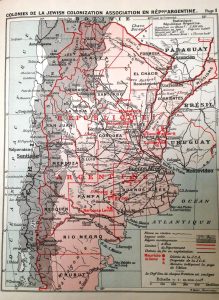
Credit: Courtesy of the University of Pennsylvania Libraries
The total Jewish farming population in Argentina hovered at 5,000 colonists during the second half of the 1890s. Starting in 1900, conditions improved steadily with the hard work of colonists and the assistance of the JCA and other Jewish philanthropic organizations from the United States and Europe. The JCA counted 20,382 farm-owning colonists in Argentina at the demographic peak of the project in 1925, with another 13,000 Jews who resided in colonies as hired workers. Decline came quickly during the 1950s; by 1964 only 782 Jewish colonists remained in Argentina with small pockets thereafter. Similar patterns unfolded in Brazil.
Moisés Ville or Moisesville
Moisesville is surely the most celebrated Jewish colony in Argentina. Founded in 1889 by a small group of immigrants from Eastern Europe, it suffered greatly in its first years.
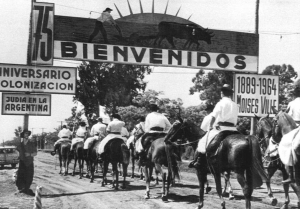
75th Anniversary Celebration of Moisesville, 1964
Credit: AMIA collection, Buenos Aires
Generally speaking, the first decade of Jewish colonization in South America was marred by failed harvests, internal conflicts, large turnover and open resistance to administrators sent by the Jewish Colonization Society. The JCA came to the rescue of the destitute pioneers of Moisesville in 1889; Mauricio was the first colony established by the JCA. These crises convinced the JCA to diversify the economic structure of the colonies, including the introduction of light industries.
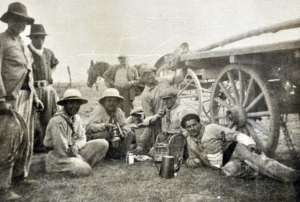
Colonists in Moisesville, late 1930s
Credit: Jewish Colonization Society photo collection, Central Archives for the History of the Jewish People, Jerusalem
View here a short video titled “Gauchos Judios” (Jewish Cattlemen) that includes vintage music and visual images from colonies around Moisesville.
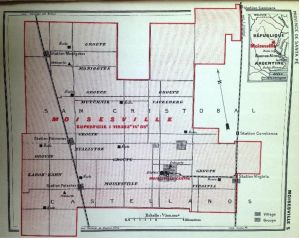
As this 1914 map shows, Moisesville was a large colony that sat at an intersection of railroad lines. It was, in fact, comprised of multiple smaller colonies, each settled by separate groups of immigrants from Eastern Europe that did not always get along.
Credit: Courtesy of the University of Pennsylvania Libraries
The agricultural diversity of Moisesville is illustrated in this chart from 1914, depicting the crops planted in Moisesville and Mauricio from 1892 (when the JCA began direct supervision of colonies) until 1912.
Key for crop planting chart
Blé – Corn…🌽
Lin – Flax…🍚
Avoine – Oats…🥣
Orge – Barley…🍺
Seigle – Rye…🌾
Mais – Maize… 🌿
Luzerne – Alfalfa…🌱
Credit: Courtesy of the University of Pennsylvania Libraries
This scale of crop diversification was relatively rare for its time, a clear sign of the modern methods introduced by Jewish support organizations. The JCA introduced livestock and other farm branches into the colonies in later years.
Simon Romero, in a report for The New York Times in 2013 wrote:
“At its height in the 1940s, this outpost on Argentina’s grasslands had four synagogues for a population of 5,000, a theater for Yiddish-language acting troupes, a newspaper filled with feverish debates about the creation of the State of Israel and saloons where Jewish gauchos galloping in from the pampas could nurse a drink alongside fellow cowhands.”
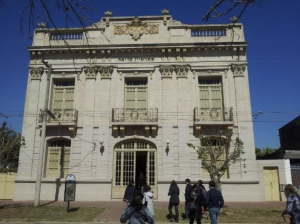
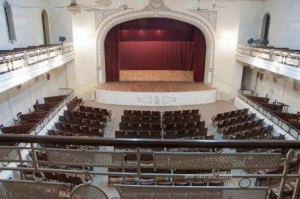
Recent photos of the exterior and interior of the “Kadima” Theater, Moisesville, Argentina. The Theater opened its doors in 1929.
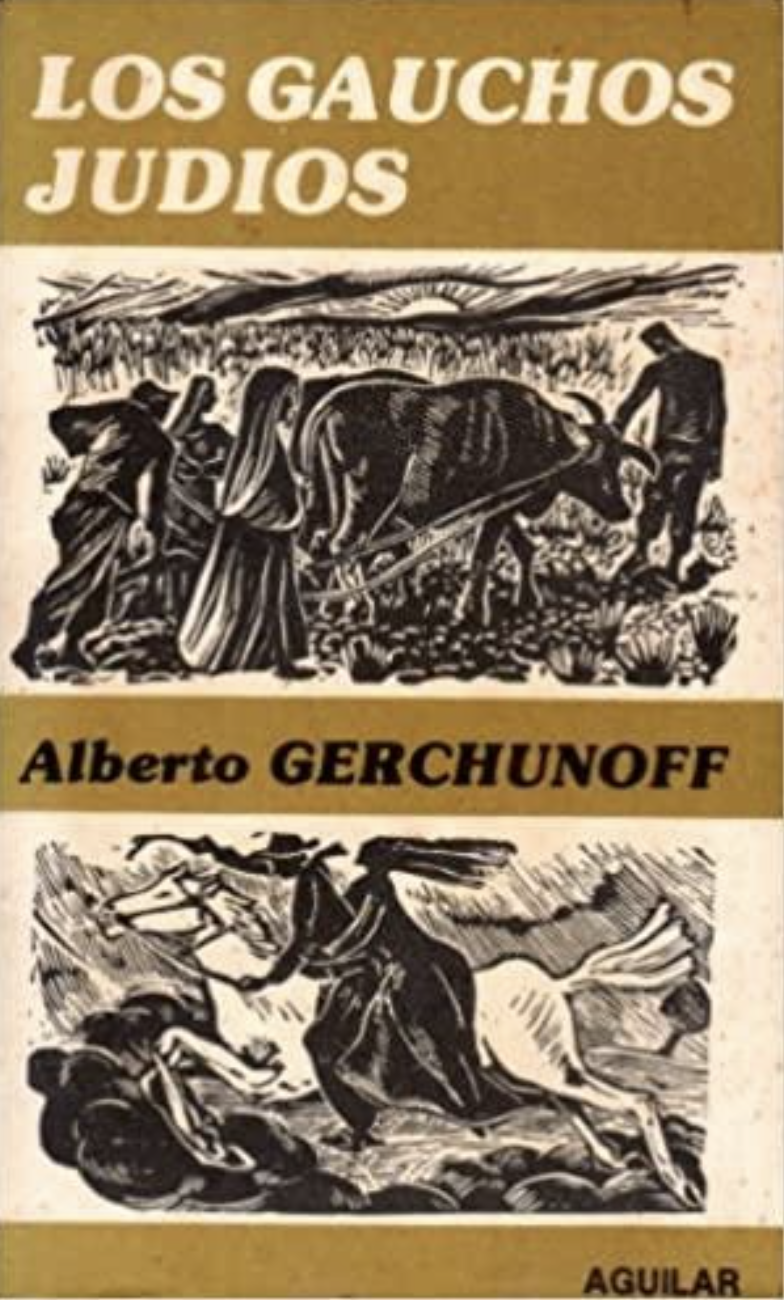
Popularization of Gerchunoff’s fictionalized version of the Jewish farming story intensified with the release in 1975 of a Spanish-language feature film based on the novel. You can view this film below.
…
Music also contributed to popular memories of Moisesville. Below is a Yiddish folk song, performed by a famous performer in the 1930s, Yevel Katz, praising Moisesville for how it built a strong Jewish community in Argentina for Jewish refugees from Eastern Europe. The clip is accompanied by archival photos from the colony’s history.
Lucienville
Moisesville, however, was only one of dozens of Argentine colonies. For example, the JCA founded Lucienville in 1894, named after the deceased son of Baron de Hirsch. The colony was founded adjacent to the existing town of Basavilbaso in the Entre Rios region, Argentina. Initially settled by 66 colonists, Lucienville grew to 245 colonists by 1912. Many hundreds more settled there in the coming decades.
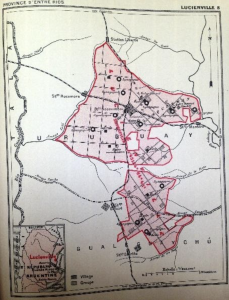
Credit: Courtesy of the University of Pennsylvania Libraries
Depicted in the above JCA map from 1914, Lucienville sat at an intersection of railroad lines, like many of the Argentine colonies. Similarly to Moisesville, Lucienville was comprised of sections, each settled by separate groups of immigrants from Eastern Europe. The map also shows locations of the many public and religious buildings that were a typical part of Jewish colonies in the Americas. The photo below, from 2008, shows the exterior of the Novibuco synagogue in Lucienville.
Credit: AMIA Collection
Lucienville was also celebrated in popular Argentine-Jewish culture. Here is a recording of “Basavilbaso,” a Yiddish song performed by Yevel Katz, celebrating farming and community life in Lucienville. The clip includes photos from the now-abandoned Novibuco synagogue, the Tefilah le-Moshe Synagogue and the Jewish Burial Society (Hevrat Kadisha) in Lucienville that served colonies in the region.

A Yevel Katz album cover from the period
Lucienville was also noteworthy because in 1900 it founded the first Jewish cooperative organization in Argentina, Sociedad Agricola Israelita. Learn more about this and other Jewish agricultural cooperatives here.
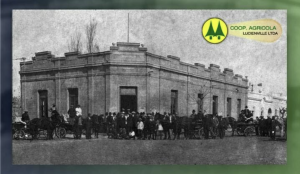
The opening celebration of Sociedad Agricola Israelita in Lucienville, 1900.
Elsewhere in South and Latin America
Besides in the main sites of Jewish colonization in Argentina and Brazil, Jewish philanthropic organizations from the United States and Europe sought places of refuge in the 1930s for Jews fleeing fascism in Europe. Because the gates of immigration closed in many western countries starting in 1924, other states in South and Latin America briefly became targets for Jewish agrarian projects. As a result, small, short-lived colonization programs emerged in Bolivia, Columbia and elsewhere on the continent, where immigration remained open.
